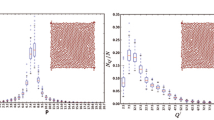Abstract
We present a toy-model for an ensemble of adhering mesoscopic constituents in order to estimate the effect of the granular temperature on the sizes of embedded aggregates. The major goal is to illustrate the relation between the mean aggregate size and the granular temperature in dense planetary rings. For sake of simplicity we describe the collective behavior of the ensemble by means of equilibrium statistical mechanics, motivated by the stationary temperature established by the balance between a Kepler-shear driven viscous heating and inelastic cooling in these cosmic granular disks. The ensemble consists of N′ equal constituents which can form cluster(s) or move like a gas—or both phases may coexist—depending on the (granular) temperature of the system. We assume the binding energy levels of a cluster E c = −N c γ a to be determined by a certain contact number N c , given by the configuration of N constituents of the aggregate (energy per contact: −γ a). By applying canonical and grand-canonical ensembles, we show that the granular temperature T of a gas of constituents (their mean kinetic energy) controls the size distribution of the aggregates. They are the smaller the higher the granular temperature T is. A mere gas of single constituents is sustained for \({T \gg \gamma a}\). In the case of large clusters (low temperatures \({T \ll \gamma a}\)) the size distribution becomes a Poissonian.
Similar content being viewed by others
References
Johnson K., Kendall K., Roberts A.: Surface energy and the contact of elastic solids. Proc. R. Soc. Lond. A 324, 301–313 (1971)
Spahn F., Schwarz U., Kurths J.: Clustering of granular assemblies with temperature dependent restitution and under Keplerian differential rotation. Phys. Rev. Lett. 78, 1596–1599 (1997)
Sremčević M., Schmidt J., Salo H., Seiß M., Spahn F., Albers N.: A belt of moonlets in saturn’s a ring. Nature 449, 1019–1021 (2007)
Spahn F., Albers N., Sremčević M., Thornton C.: Kinetic description of coagulation and fragmentation in dilute granular particle ensembles. Europhys. Lett. 67, 545–551 (2004)
Brilliantov N.V., Albers N., Spahn F., Pöschel T.: Collision dynamics of granular particles with adhesion. Phys. Rev. E 76(5), 051301 (2007)
Yeomans J.M.: Statistical Mechanics of Phase Transitions. Clarondon Press, Oxford (1992)
Astumian R.D.: The unreasonable effectiveness of equilibrium theory for interpreting non-equilibrium experiments. Am. J. Phys. 74, 683–688 (1996)
Niven R.K.: Steady state of a dissipative flow-controlled system and the maximum entropy production principle. Phys. Rev. E 80, 021113 (2009)
Soto R., Argentina M., Clerc M.G.: van der Waals like transition in fluidized granular matter. Lect. Notes Phys. 624, 317–333 (2003)
Albers N., Spahn F.: Influence of particle adhesion on the stability of agglomerates in Saturn’s rings. Icarus 35, 292–301 (2006)
Heitmann R., Radin C.: The ground state for sticky disks. J. Stat. Phys. 22(3), 281–287 (1980)
Author information
Authors and Affiliations
Corresponding author
Rights and permissions
About this article
Cite this article
Baibolatov, Y., Spahn, F. The role of adhesion for ensembles of mesoscopic particles. Granular Matter 14, 197–202 (2012). https://doi.org/10.1007/s10035-012-0325-4
Received:
Published:
Issue Date:
DOI: https://doi.org/10.1007/s10035-012-0325-4




